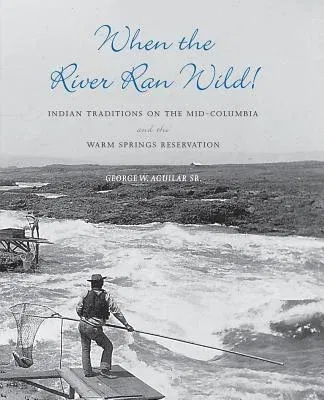"Nearly seventy-five years of my lifetime have come and gone since
hearing of the sparse historical events from the old-timers," American
Indian elder George Aguilar tells us. "It's my turn now." When the
River Ran Wild! is Aguilar's recounting of events he heard about while
watching his grandmother make moccasins by the light of a coal-oil lamp
and while strapped to the back of his aunt's horse on the way to the
huckleberry grounds. He learned them at Coyote's Fishing Place, where
his uncles built scaffolds and taught him how to use traditional
technologies to catch salmon as they made their seasonal runs up the
river.
In this remarkable personal memoir and tribal history, we learn about
Aguilar's people, the Kiksht-speaking Eastern Chinookans, who lived and
worked for centuries connected to the rhythms and resources of the great
fishing grounds of the Columbia River at Five Mile Rapids.
When the River Ran Wild! is the story of a culture and a community
that has undergone tremendous change since 1805, when the River People
encountered Meriwether Lewis and William Clark as they traveled down the
Columbia River on their way to the Pacific Ocean. To find the stories of
that change, Aguilar draws on the journals and diaries of early White
missionaries and settlers, such as Gabriel Franchere, Rev. Henry Perkins
of Wascopum Mission, and A. B. Meacham. He found other stories in
anthropological papers and historical studies that recorded the voices
of people who practiced and remembered ceremonies and traditions that
were lost or changed during the difficult years of removal to the Warm
Springs Reservation in north-central Oregon. He heard yet others from
tribal elders who have kept the history and stories of the River People
in their memories.
When the River Ran Wild! is the history of names and naming, of deep
family connections, and of traditional customs. It is a descriptive
catalogue of the plants the River People used for sustenance and medical
purposes, and it is a detailed guide on how to pack out an elk and how
to tan a hide. Aguilar retells the stories and myths of the river, the
stories that "are now infrequent and told from books in the English
language," the stories whose "body language, animal mimicry, and facial
expressions are gone."
Aguilar has written this book to help us know what the River People have
lost on the Columbia River over the decades, but he also gives testimony
to what has been conserved and enlivened by a people who love the land
and who honor tradition and those who came before. He takes us, perhaps
better than anyone else can, back to a time when the river ran wild.

